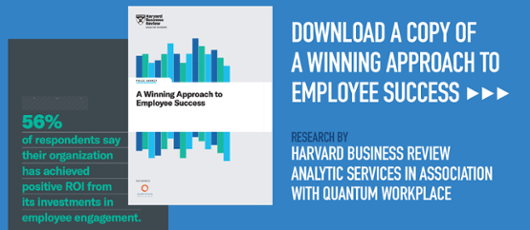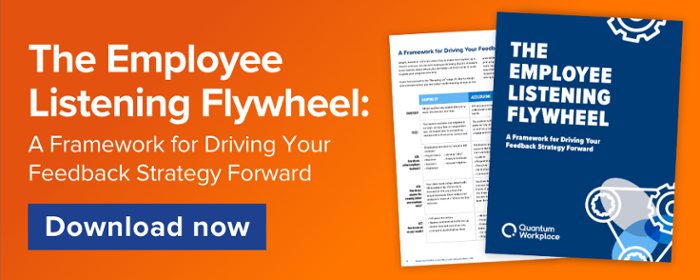The Importance of Employee Engagement in 2025
In recent years, the employee engagement landscape has dramatically shifted. During the COVID-19 pandemic, employers were deeply invested in all things culture and engagement, focusing on employee well-being, safety, and connection as employees were dispersed and navigating a global crisis. As the pandemic fades into our memories, and economic pressures have since mounted, employers are now intensely focused on performance and productivity–sometimes at the expense of employee engagement.
But here's the truth. High performance and strong engagement are inextricably connected. Simply put, you cannot sustain one without the other. Engaged employees perform better. They are more motivated, aligned, and willing to go above and beyond for the good of their team and organization. And when performance expectations are clear and are employee are getting effective coaching and feedback, they're more engaged. Even in an employer's market, engagement remains a critical lever for retaining top talent and driving business success.
Research shows that engaged employees deliver better results, with about 81% of executives strongly agreeing that engaged employees perform at a higher level.
But many employers struggle to balance these priorities effectively–often investing in one more heavily than the other. When organizations prioritize performance over engagement, they see a drop in productivity. Employees feel like worker bees, feel unheard, feel disempowered. Similarly, when employers focus solely on feel-good engagement initiatives (like perks and pizza parties) without setting clear performance expectations, productivity suffers. Competing priorities can stifle organizational culture, limiting employee potential, innovation, and competitive edge.
12 Top Employee Engagement Benefits
Organizational Performance Benefits
Engaged employees drive success across the organization. When employees feel connected, motivated, and invested in their work, they achieve tangible business results. Companies that engage their employees consistently outperform their competitors in key areas such as profitability, sales, quality output, productivity, and customer service.

1. Higher Profitability
An engaged workforce leads to higher profitability. Engaged employees work more efficiently, make better decisions, and are more likely to go the extra mile, which contributes to increased profits.
Studies reveal that companies with high employee engagement enjoy up to 21% higher profitability than their disengaged counterparts. The Harvard Business Review Analytic Services research linked above indicates that 56% of organizations achieve positive ROI from their investments in employee engagement.
2. Increased Sales
Another benefit of employee engagement is increased sales. Engaged employees enthusiastically connect with prospects and customers, understand their needs, and provide solutions that directly boost sales. Companies with highly engaged employees experience sales increases of over 20% compared to those with low levels of engagement.
3. Enhanced Quality of Work
Engaged employees take pride in their work, pay attention to details, and commit to delivering high-quality products or services. Their attention to quality enhances customer satisfaction and reduces costly rework, returns/refunds, and customer complaints.
4. Greater Productivity
An engaged workforce enhances productivity, which serves as a primary business goal for organizations investing in employee engagement, as indicated by around 53% of businesses. Engaged employees maintain focus, show motivation, and willingly put in extra effort. They waste less time on non-work-related activities and work more efficiently. Companies with highly engaged employees report productivity gains of up to 17%.
5. Better Customer Service
Engaged employees actively go above and beyond to ensure customer satisfaction. They remain attentive, responsible, and committed to providing superb service. Customer happiness directly and positively impacts loyalty, referrals, and revenue. Approximately 72% of companies strongly agree that highly engaged employees promote a happy workforce.
Operational Advantages
6. Reduced Absenteeism
Highly engaged employees genuinely want to be at work, which is why they miss work less often. This significant reduction in absenteeism (41% lower in companies with high engagement levels) enables consistent operations and boosts productivity.
7. Increased Employee Retention
52% of organizations cite employee retention as a primary goal for their employee engagement initiatives. Employees who love their jobs and feel valued by their employers are more likely to stay. Engaged workforces lead employers to experience 24% lower turnover. As an employer, you understand that maintaining top talent is crucial for preserving institutional knowledge, skills, and relationships within the company. All of these factors are essential for driving business success.
8. Stronger Employee Loyalty & Advocacy
Engaged employees feel a deep attachment and loyalty to their employer, going beyond mere presence. Departments with engaged employees achieve an impressive 59% higher employee loyalty and retention. These employees act as true brand ambassadors, often going above and beyond while also attracting additional top talent.
Impact on Employee Well-Being
Employees who feel genuinely connected to their employer and its purpose tend to experience greater job satisfaction, enjoy better physical and mental health, and achieve an improved work-life balance. These benefits extend beyond their jobs and positively impact their lives at home.
9. Increased Safety
When considering engaged employees, we often overlook increased safety. Employees who are highly engaged remain more present, attentive, and committed to everything, including following safety protocols! Their heightened awareness and attention to detail help prevent workplace accidents and injuries, creating a much safer workplace.
10. Healthier Behaviors
A balanced diet and sufficient sleep not only pay off at home but also benefit work performance! Engaged employees are more likely to exercise regularly, maintain a balanced diet, and get sufficient sleep. This positive lifestyle shift improves physical health, reduces stress, and enhances overall well-being. When people feel good, they take fewer sick days, incur lower healthcare costs, and experience fewer health issues.
11. Better Work-Life Balance
Engagement profoundly impacts employees' lives as well. Employees who feel fulfilled and satisfied at work manage stress better and achieve a healthier work-life balance. This engagement may lead to stronger personal relationships, improved family dynamics, and a greater sense of overall satisfaction.
12. Happiness and Contentment
When employees are engaged, they generally experience greater happiness and contentment at work and at home. They develop a strong sense of purpose, feel genuinely valued for their contributions, and cultivate a deeper emotional connection to their organization. This positive mindset boosts resilience, enhances problem-solving abilities, and fosters an optimistic outlook.

Critical Employee Engagement Trends & Challenges to Watch (and Act On) in 2025
In 2025, organizations will prioritize employee engagement to remain competitive and retain key talent. Neglecting engagement poses certain risk, causing employees to play the “waiting game.” Some turnover is good turnover, but you do not want your key talent planning for their exit. Ignoring employee signals of departure and overlooking engagement can result in losing critical talent, decreased productivity, and reduced profitability.
Turnover of Critical Talent
One of the most pressing challenges for 2025 is the risk that organizations will lose their high-performing employees when the job market improves. Around 85% of senior executives identify retention as a top ten issue. Engaged employees are more likely to stay loyal to their employers, but they may seek new roles if their needs remain unmet. Organizations must recognize that employees are their most valuable asset and take preventive measures to retain key talent. These measures might look like offering competitive compensation, providing clear growth trajectories, and fostering a culture of recognition and appreciation. More importantly, make sure you have the tools you need to detect turnover risk, understand turnover drivers, and take action.
Competitive Compensation & Incentives
Fair and attractive compensation packages are essential for employees and crucial for retaining them, but the story goes deeper. Pay reflects employees' perceived value and signals their future opportunities within the organization. When employees leave, they often cite pay as a reason linked to feeling undervalued or recognizing limited growth potential. Leaders should view compensation as part of a complete strategy. They should add performance-based incentives and top-tier benefits to their compensation packages. This balanced approach retains top talent and aligns with business objectives.
Clear & Meaningful Growth Opportunities
Everyone wants to know their “next step.” This desire drives employees to seek growth opportunities, making viable growth critical to employee engagement. Employees want to actively pursue continuous learning, skill development, and career advancement. By providing a clear path for professional growth within your organization, you can foster purpose and commitment, reducing the likelihood of employees seeking opportunities elsewhere.
Continuous Listening: Not Settling for "Good Enough"
We’ve all heard someone say “good enough” when they settle for subpar work. This mindset doesn’t meet the demands of today’s landscape. You’ve probably heard the idiom, “The only constant in life is change.” This saying rings more true than ever for employers who engage their employees. Organizations must actively cultivate a culture of continuous improvement by regularly seeking employee feedback and taking meaningful actions based on that input. A strategic employee listening program allows companies to adapt appropriately to changing market conditions while keeping cultural initiatives relevant.
Offering Flexibility that Meets Employee & Business Needs
Many organizations have adapted to meet the demand for flexibility that many employees value. By offering flexible work arrangements, companies enhance work-life balance and increase employee satisfaction. Quantum Workplace research shows that employees are nearly two times more likely to be highly engaged when they perceive flexibility as a significant benefit in their organization. Additionally, employees who receive flexible options are 1.7 times more likely to stay with their current employer and 2.4 times less likely to search for or apply for other job opportunities.
While organizations need to meet employees where they are—and implement flexibility fairly and consistently—they need to do so in a way that doesn't have a negative impact productivity or team dynamics.
Connecting with Sense of Purpose
Organizations must connect day-to-day work to a deeper purpose to sustain employee engagement. Employees seek a sense of fulfillment in their roles, and 65% of them report that their company culture has changed post-pandemic. Leaders need to clarify their mission, vision, values, and general purpose for employees.
Our research shows that 54% of employees feel the strongest connection to culture through their organization's mission and values. Aligning contributions with a greater purpose engages employees’ motivations, fostering a shared sense of success. Furthermore, 66% of employees believe that their culture positively impacts their work and behavior daily.

Driving Employee Engagement as a Continuous Cycle

Successful employee engagement follows a proven cycle: ASK, AHA, and ACT.
Start by ASKING. Capture honest feedback through surveys and create an environment where employees feel safe sharing their true thoughts and feelings. This approach lays the groundwork for those AHA moments, as you analyze the data to uncover key insights, trends, and areas for improvement.
Finally, ACT decisively by implementing changes based on these insights and ensuring employees stay involved in the process. This process continues as you measure progress and gather new feedback, creating a continuous improvement flywheel. To maximize this approach:
- Deploy an annual engagement survey to establish a baseline and see trends over time.
- Launch regular pulse surveys to dive deeper on important topics.
- Use modern employee survey technology to gather real-time feedback and surface critical insights.
- Track metrics like engagement scores, retention rates, and business KPIs.
- Connect engagement and retention efforts to business outcomes.
- Align engagement initiatives with organizational goals.
- Empower managers and leaders to drive engagement of their teams.
- Communicate often and transparently, opening up two-way dialogue often.
- Recognize employee achievements consistently and authentically.
Successfully driving employee engagement requires dedicating resources, securing organization-wide support, and committing to continuous improvement. Employers who master this flywheel foster a culture where engagement drives performance, innovation, and business success. Most importantly, they show employees that their voices matter and that they hold the power to influence positive organizational change.
Employee Engagement Roles in Your Organization
The Role of Employees
Who is responsible for employee engagement? The answer is multifaceted, but let’s start with employees. Without honest feedback from employees, you cannot know if your employee engagement strategy works. Employees play a crucial role in ensuring the success of engagement initiatives. They must be willing to provide open and honest feedback about their work experiences and collaborate with managers and leaders to develop solutions.
Employees should strive to understand why initiatives are implemented and how those initiatives will impact their experiences. They need to carefully consider and share what would most improve their experience. Additionally, employees must communicate feedback openly, brainstorm solutions, and support their team's commitments.
The Role of HR
HR plays a vital role in aligning leaders, managers, and employees around employee engagement. HR acts as a driver and a coach, engaging all levels of the organization in employee success initiatives. They partner with stakeholders to implement strategies and help define, launch, communicate, measure, and adjust key initiatives.
HR also influences and informs senior leaders, empowers and equips managers, and supports employees. They build processes and systems and secure the right tools and technology for the organization to thrive. HR implements the employee engagement strategy, taking ownership of the “how.” They focus on driving alignment and accountability. And choose processes and tools that measure and drive employee engagement while coaching leaders and teams.
The Role of Managers
Managers play a pivotal role in encouraging and driving employee engagement within an organization. By implementing a coaching culture, managers empower their teams to reach their fullest potential. Providing regular feedback, both positive and constructive, is essential for growth and development. Managers need to equip themselves with the tools and training to deliver effective feedback that resonates with team members and fosters a culture of honesty.
Managers also require ongoing learning opportunities to continuously improve, much like individual contributor employees. As the workforce evolves, managers must adapt their approaches to meet their team’s changing needs. Investing in management development programs equips managers with the knowledge and techniques to navigate complex situations, inspire their teams, and drive engagement.
The Role of Senior Leaders
Effective employee engagement strategies require strong leadership commitment and alignment with an organization’s strategic objectives. Leaders actively encourage and cultivate a culture that values and promotes engagement, fostering an environment where employees feel valued, respected, and empowered to contribute their best efforts.
Leaders need to communicate clearly and consistently to ensure that employees understand the organization's vision and goals and recognize their importance in achieving them. They should actively explain the significance of employee engagement and its impact on the organization’s success, reinforcing this message through their actions and decision-making.
Finally, leaders must actively participate in planning employee engagement initiatives. This includes allocating resources, setting measurable goals, and monitoring progress. By demonstrating their commitment through actions, leaders can inspire and motivate their teams to embrace and cultivate a culture of engagement.
The Future of Employee Engagement is Here: How are You Preparing?
The workplace is shifting before our eyes. Organizations once prioritized culture and engagement primarily through the lens of well-being and connection. However, economic pressures now demand more focus on performance and productivity. This shift creates a critical inflection point: balancing high performance with strong engagement.
Research further validates this, with 81% of executives agreeing that engaged employees deliver superior performance. Nevertheless, employers must strike the right balance by avoiding the following:
- Overemphasizing performance and disregarding employee engagement
- Focusing solely on "feel good" engagement tactics and failing to set clear performance expectations and accountabilities
- Neglecting both elements and stifling connection, alignment, innovation, and competitive advantage
Technology will play a pivotal role in shaping the future of employee engagement. Detailed analytics will empower organizations to gather real-time insights into employee sentiment, further personalize engagement, and streamline open feedback loops. AI will help up-skill people leaders and decrease burden on HR teams who can't possibly manage it all.
Investing in the right employee engagement platform can change the game, helping organizations can stay ahead of the curve and cultivate a highly engaged, highly motivated workforce.
Finally, long-term planning for employee engagement success requires a strategic approach. Employers need to align engagement and culture initiatives with business objectives—and not be too slow to act when critical insight surfaces. Based on insights gleaned, they must allocate the appropriate resources and engage in continuous measurement and refinement.
Successful organizations will approach engagement and action with this mindset: Starting small is better than not starting at all.
Enhance your employee listening strategy
It’s time to put the wheels in motion as you tackle employee engagement. Dive into employee listening to unlock the full potential of your strategy. Download your copy of the comprehensive guide, “The Employee Listening Flywheel: A Framework For Driving Your Feedback Strategy Forward' today.

Learn more about how Quantum Workplace can help you maximize employee engagement & retention

Experience how Quantum Workplace’s employee engagement platform helps your organization swiftly move from insight to action. Collect feedback, uncover powerful insights, and take confident, efficient action.
Book a demo today to connect with one of our experts and receive a personalized walkthrough of our employee engagement software.
FAQs
What is employee engagement?
Employee engagement represents the strength of the mental and emotional connection that employees feel toward their organization, their team, and their work. It reflects how invested employees are emotionally in their roles and the organization's goals. Engaged employees typically show high commitment, increase productivity, and positively contribute to the company culture. They work not just for a paycheck or the next promotion, but because they genuinely care about their work and are motivated to contribute to the organization's success.
Why is employee engagement important to HR?
Employee engagement is vital to HR because it directly impacts key workforce metrics like productivity, retention, well-being, and culture. Highly engaged employees serve as brand ambassadors, perform better, embrace change, and remain with an organization for a longer time. In contrast, disengaged employees show lower productivity and are more likely to leave, which negatively affects culture and the customer experience.
What are the types of employee engagement?
Types of employee engagement include: Work engagement, or how connected am I to the work I’m doing? Team engagement, or how connected do I feel to my immediate coworkers? Organizational engagement, or how connected am I to the organization?
How to improve employee engagement in the workplace?
You can improve employee engagement in many ways, such as providing meaningful work, fostering effective leadership, offering growth opportunities, ensuring fair pay and recognition, promoting work-life balance, enhancing strong communication, and cultivating a values-driven culture.
What are common employee engagement examples?
Active employees speak positively about their organization, go above and beyond, actively solve organization-wide problems, maintain a strong work ethic, embrace change, and take pride in their work.
What are proven employee engagement strategies?
Organizations that invest in leadership training boost team performance and retention. Strong management creates a waterfall effect throughout the organization, positively impacting each employee's experience. Employers must establish clear communication channels that encourage feedback from all levels. Career development opportunities motivate employees and keep them invested in the company’s success and future. Regular recognition celebrates employee achievements and reinforces positive behavior. Modern employees seek a solid work-life balance. Leading companies respond to this call with flexible policies that respect employee desires. These organizations foster inclusive environments where diverse perspectives thrive and productivity rises.
What are the main challenges of employee engagement?
Leadership misalignment quickly undermines employee engagement. When executives fail to demonstrate commitment to engagement programs, they erode employee trust. Communication gaps create uncertainty and confusion. Limited growth opportunities push highly engaged employees to seek jobs elsewhere. Excessive workloads cause burnout, and inadequate compensation packages drive employees to different organizations. Toxic workplace cultures erode engagement from within. Organizations that ignore employee feedback or fail to address systemic issues witness declining employee engagement, morale, and turnover. Constant change without clear direction breeds feelings of instability and disconnection.
How do you measure the impact of employee engagement on productivity?
Evaluate metrics such as labor hours, sales per employee, and customer satisfaction scores to gauge the productivity impact. Compare these numbers to those of disengaged employees and analyze the trends to quantify your efforts.
What are the benefits of employee engagement in the workplace?
Key benefits include increased productivity, higher profitability, enhanced customer loyalty, better quality, and improved safety. Engaged organizations experience lower absenteeism and turnover, foster greater employee loyalty and advocacy, achieve improved hiring success, and strengthen their employer brand.
What are the social benefits of employee engagement in the workplace?
Engaged employees enjoy better physical and mental health, build stronger work relationships, experience higher job satisfaction, and manage stress more effectively while maintaining a better work-life balance. Engagement fosters greater collaboration, inclusion, and community.















